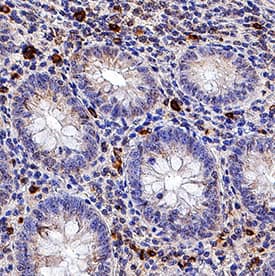Recombinant Human Nectin-3 Protein, CF Summary
Product Specifications
KD <120 nM.
Leu56-Asp400 & Gly58-Asp400, with a C-terminal 6-His tag
Analysis
Customers also Viewed
Product Datasheets
Carrier Free
CF stands for Carrier Free (CF). We typically add Bovine Serum Albumin (BSA) as a carrier protein to our recombinant proteins. Adding a carrier protein enhances protein stability, increases shelf-life, and allows the recombinant protein to be stored at a more dilute concentration. The carrier free version does not contain BSA.
In general, we advise purchasing the recombinant protein with BSA for use in cell or tissue culture, or as an ELISA standard. In contrast, the carrier free protein is recommended for applications, in which the presence of BSA could interfere.
3064-N3
| Formulation | Lyophilized from a 0.2 μm filtered solution in PBS. |
| Reconstitution | Reconstitute at 100 μg/mL in sterile PBS. |
| Shipping | The product is shipped with polar packs. Upon receipt, store it immediately at the temperature recommended below. |
| Stability & Storage: | Use a manual defrost freezer and avoid repeated freeze-thaw cycles.
|
Background: Nectin-3
Nectins are a small family of Ca++-independent immunoglobulin (Ig)-like cell adhesion molecules (CAMs) that organize intercellular junctions (1, 2, 3, 4). The Nectin family has at least four members (Nectin-1 - 4), all of which show alternate splicing, a transmembrane (TM) region (except for Nectin-1 gamma ), and three extracellular Ig-domains. Nectins are highly homologous to the human receptor for poliovirus, and as such, have been alternatively-named poliovirus receptor-related proteins. They do not, however, appear to bind poliovirus (1). Nectin-3 (also named PRR3, CD113 and PVRL3) is an 83 kDa, type I TM glycoprotein. Its precursor is 549 amino acids (aa) in length. It contains an extended signal sequence of 57 aa, an extracellular domain (ECD) of 347 aa, a transmembrane segment of 21 aa (aa 405 - 425), and a cytoplasmic region of 124 amino acids. The ECD shows three Ig-like domains; one N-terminal V-type and two membrane-proximal C2-type. The cytoplasmic region shows a Glu-Trp-Tyr-Val motif that binds afadin (3, 5, 6). The ECD of human Nectin-3 is 94% aa identical to mouse Nectin-3 ECD (5, 6). Nectin-3 has a diverse expression pattern. It has been found in junctions between small intestinal columnar epithelial cells (6), pigmented and nonpigmented epithelium in the ciliary body (7), spermatids and Sertoli cells in the seminiferous tubules (8), and on spinal cord motor neurons and axons, plus Schwann cells of the peripheral nervous system (9). As with mouse, human Nectin-3 has three potential isoforms. It does not appear that they are strict orthologs. In addition to the full length isoform, a second human isoform has a 31 aa substitution for the first 54 aa of the signal sequence, followed by a deletion of aa 291 - 549 (10). The third human isoform shows a 10 aa substitution for aa 357 - 549 (11). Nectin-3 is proposed to promote cell adhesion by initiating cell-to-cell adhesion, allowing for subsequent JAM and cadherin-based intercellular junction formation. It does so by first forming same cell (cis-) heterodimers with alpha v beta 3 and PDGFR (an anti-apoptotic interaction) (2, 4). This results in actin reorganization and recruitment of adherens and occludins adhesion molecules. Subsequent Nectin-3 activity adds strength to the junction through trans-interactions with a variety of molecules, including Nectin-3 itself, as well as Nectins-1 and 2 plus Necl-1, 2 and 5 (3, 4).
- Takai, Y. and H. Nakanishi (2003) J. Cell Sci. 116:17.
- Miyoshi, J. and Y. Takai (2007) Am. J. Nephrol. 27:590.
- Sakisaka, T. et al. (2007) Curr. Opin. Cell Biol. 19:593.
- Rikitake, Y. and Y. Takai (2008) Cell. Mol. Life Sci. 65:253.
- Reymand, N. et al. (2000) Gene 255:347.
- Satoh-Horikawa, K. et al. (2000) J. Biol. Chem. 275:10291.
- Inagaki, M. et al. (2005) Development 132:1525.
- Inagaki, M. et al. (2006) Genes Cells 11:1125.
- Zelano, J. et al. (2006) Exp. Neurol. 201:461.
- GenBank Accession # BAC11414.
- SwissProt # Q9NQS3.
FAQs
No product specific FAQs exist for this product, however you may
View all Proteins and Enzyme FAQsReviews for Recombinant Human Nectin-3 Protein, CF
There are currently no reviews for this product. Be the first to review Recombinant Human Nectin-3 Protein, CF and earn rewards!
Have you used Recombinant Human Nectin-3 Protein, CF?
Submit a review and receive an Amazon gift card.
$25/€18/£15/$25CAN/¥75 Yuan/¥2500 Yen for a review with an image
$10/€7/£6/$10 CAD/¥70 Yuan/¥1110 Yen for a review without an image
















